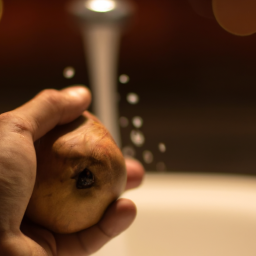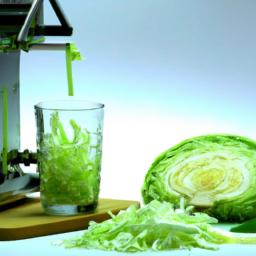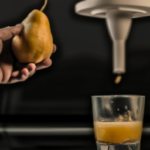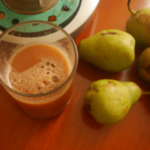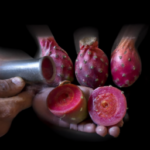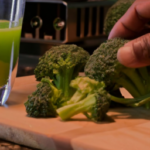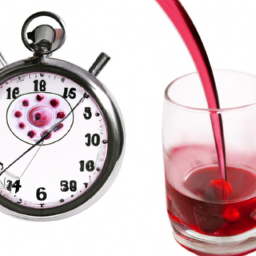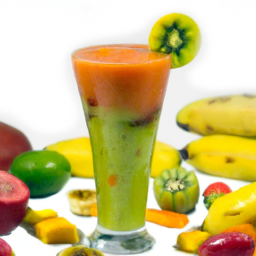Pears are a great option for juicing due to their sweet and juicy flavor. Making juice from pears results in a nutritious and delicious beverage that is easy to make and enjoyable to consume.
As a juicing enthusiast, I have experimented with various fruits and vegetables, but pear juice remains one of my favorites due to its unique flavor and numerous health benefits. Pears are a good source of fiber, vitamin C, and antioxidants, making them an excellent addition to any healthy diet.
Juicing pears is an easy way to consume these nutrients without having to eat large quantities of fruit. In this article, I will guide you through the process of juicing pears, from choosing the right pears to storing the juice.
Whether you are a beginner or an experienced juicer, this guide will help you create delicious and nutritious pear juice that you can enjoy at any time of the day.
Key Takeaways
- Juicing pears is an easy way to consume nutrients like fiber, vitamin C, and antioxidants without having to eat large quantities of fruit.
- Choosing ripe pears with a sweet aroma and removing the core and any seeds is important for preparing pears for juicing.
- Masticating juicers are the most efficient option for juicing pears and preserving their nutrients and flavor.
- Pears can be paired with other ingredients like ginger, lemon, and cucumber to create a well-rounded and nutrient-dense juice.
Benefits of Juicing Pears
You’ll love how juicing pears can give you a boost of nutrients and support your overall health. Juicing techniques can help you extract the maximum amount of nutrients from pears, including vitamins C and K, fiber, and antioxidants. These nutrients can help to support your immune system, improve digestion, and promote heart health.
In addition to being a great source of nutrition, pears are also low in calories and high in water content, making them an excellent choice for weight loss and hydration. By incorporating juiced pears into your diet, you can enjoy the many health benefits they offer, while also satisfying your taste buds with their sweet, refreshing flavor.
Now, let’s move on to choosing the right pears for juicing.
Choosing the Right Pears
Although some pears may feel firm to the touch, they can still be ripe and juicy. When choosing ripe pears for juicing, it’s important to look for signs of ripeness such as a slight give when pressed gently near the stem or a sweet aroma. Different pear varieties also have varying degrees of ripeness, with some being best for juicing when slightly underripe while others are best when fully ripe. Here’s a table to help you choose the right pears for your juice:
| Pear Variety | Best for Juicing When | Flavor Profile |
|---|---|---|
| Bartlett | Slightly Underripe | Sweet, Juicy |
| Bosc | Slightly Underripe | Rich, Buttery |
| Anjou | Fully Ripe | Mild, Sweet |
When selecting pears for juicing, keep in mind that the best flavor is often achieved when using a mix of different varieties. Don’t be afraid to experiment with different combinations to find your perfect blend. Moving on to preparation, once you’ve chosen your pears, it’s time to prepare them for juicing.
Preparation
After selecting the perfect pears for your recipe, it’s time to get them ready for the juicer. First, it’s important to determine the ripeness level of the fruit. Pears that are too ripe will be too soft and may not juice well, while those that are too firm may not yield enough juice. To test the ripeness, gently press the pear near the stem. If it gives a little, it’s ready to juice.
Next, you’ll want to prepare the pears by cutting them into smaller pieces that will fit into the juicer chute. Start by washing the fruit thoroughly and removing any stems or leaves. Cut off the top and bottom of the pear, then slice it in half from top to bottom. Remove the core and any seeds with a knife or spoon, and cut the pear into smaller chunks if necessary.
With the pears properly prepared, it’s time to move on to the equipment needed for juicing.
Equipment Needed
Let’s talk about the necessary equipment for getting the most out of your juicy pears. To start, you will need a juicer. There are various types of juicers available in the market, but the most efficient one for juicing pears is a masticating juicer. This type of juicer works by slowly grinding and pressing the fruits, extracting the juice without heating it up, which preserves the nutrients and flavor of the pear. A centrifugal juicer is another option, but it works by spinning the fruit at high speeds, which generates heat and can affect the flavor and quality of the juice.
Apart from the juicer, you will also need a knife, a cutting board, and a bowl to hold the sliced pears. It’s essential to choose ripe pears for juicing, as they will provide the most flavor and juice yield. When it comes to flavor combinations, pears pair well with ginger, lemon, and cucumber. You can also add some greens to your pear juice, such as kale or spinach, to boost its nutritional value. Now that you have your equipment ready, let’s move on to the juicing techniques.
Note:
| Equipment | Type | Purpose |
|---|---|---|
| Juicer | Masticating or Centrifugal | Extract juice from the pears |
| Knife | Sharp blade | Cut the pears into smaller pieces |
| Cutting Board | Flat surface | Hold the pears while cutting them |
| Bowl | Wide container | Collect the sliced pears and juice |
This table provides the audience with a clear understanding of the equipment needed and its purpose. By using a masticating juicer, they can extract more juice from the pears while preserving its flavor and nutrients. Additionally, the table also highlights the importance of using a sharp knife and a cutting board to prepare the pears properly. In the next section, we will discuss some juicing techniques that can help you get the most out of your pear juice.
Juicing Techniques
When it comes to juicing techniques, I typically focus on three key areas: single fruit juicing, mixing with other fruits and vegetables, and adding spices and herbs.
Single fruit juicing is a great option if you want to highlight the unique flavor and nutritional benefits of a particular fruit.
Mixing fruits and vegetables can help you create a more well-rounded and nutrient-dense juice.
Adding spices and herbs can give your juice an extra kick of flavor and health benefits.
By experimenting with these techniques, you can create delicious and nutritious juices to fuel your body.
Single Fruit Juicing
Juicing a pear is as easy as slicing it into smaller pieces and placing them in a juicer. However, there are a few things you can do to make the process even smoother and yield better results. Here are some tips that I’ve found helpful when juicing pears on their own:
-
Choose the right type of pear: Not all pears are created equal when it comes to juicing. Bartlett and Anjou pears tend to yield the most juice and have a naturally sweet flavor that works well in juices. Avoid using overly ripe pears, as they can be too soft and mushy to juice effectively.
-
Cut the pear into small pieces: While you don’t need to worry about removing the seeds or skin, cutting the pear into smaller pieces will make it easier to juice. This is especially important if you’re using a centrifugal juicer, which requires smaller pieces in order to extract the most juice.
-
Clean your juicer thoroughly: Pears can be quite juicy, and their juice can be sticky and thick. Be sure to clean your juicer thoroughly after juicing pears to prevent any buildup or clogging.
Now that you know how to juice a pear on its own, you may be wondering how to mix it with other fruits and vegetables. Let’s explore some flavor combinations that work well with pear juice.
Mixing with Other Fruits and Vegetables
Get creative with your juicing and try mixing pears with a variety of fruits and vegetables to create delicious and nutritious blends. Juice pairing is a great way to combine flavors and nutrients to create a unique and satisfying drink. For example, mixing pears with apples and carrots creates a sweet and refreshing juice that’s loaded with vitamins and antioxidants.
When choosing fruits and vegetables to mix with pears, consider their nutritional value. Leafy greens like kale and spinach are packed with vitamins A, C, and K, while cucumbers and celery are hydrating and low in calories. Adding a small piece of ginger or lemon can also provide a zesty kick and additional health benefits.
Experiment with different combinations to find your favorite juice pairing that satisfies your taste buds and nutritional needs.
Now that you know how to mix pears with other fruits and vegetables, it’s time to take your juicing to the next level by adding spices and herbs.
Adding Spices and Herbs
In my previous section, I discussed the art of mixing other fruits and vegetables with pears to create a delicious and nutritious juice. However, if you’re looking to take your pear juice to the next level, adding spices and herbs can give your drink a unique flavor and added health benefits.
One of my favorite flavor combinations is adding ginger to pear juice. Ginger has a warming and spicy flavor that pairs well with the sweetness of pears. Additionally, ginger has been used as an herbal remedy for centuries to aid in digestion and reduce inflammation. Another great herb to add to pear juice is mint. Not only does mint add a refreshing taste, but it also has been shown to aid in digestion and relieve symptoms of nausea. Below is a table outlining different spice and herb options for pear juice.
| Spice/Herb | Flavor Profile | Health Benefits |
|---|---|---|
| Cinnamon | Warm and sweet | Regulates blood sugar, contains antioxidants |
| Turmeric | Earthy and pungent | Anti-inflammatory, aids in digestion |
| Rosemary | Woody and aromatic | Improves memory and concentration |
| Basil | Sweet and slightly peppery | Contains anti-inflammatory properties |
| Thyme | Earthy and slightly minty | Immune-boosting, aids in digestion |
As you can see, there are many options for adding spices and herbs to pear juice to create unique flavor combinations and added health benefits. In the next section, I will discuss the best methods for storing your freshly juiced pear juice.
Storing Pear Juice
When it comes to storing pear juice, there are a few key factors to consider. I’ve found that refrigeration is the best option for short-term storage, as it helps to preserve the nutrients and flavor of the juice. However, if you’re looking to store pear juice for longer periods of time, freezing is a great option that can extend the shelf life by several months.
So, to summarize: refrigeration for short-term storage and freezing for longer-term storage.
Refrigeration
To keep your pear fresh and juicy for longer, you’ll want to refrigerate it, even though you might be tempted to leave it out on the counter. Refrigeration can extend the shelf life of your pears and keep them at their optimal freshness. By storing pears in the fridge, you can avoid spoilage and maintain their texture and flavor.
Below is a table summarizing the benefits of refrigeration and the best storage techniques to keep your pears fresh:
| Benefits of Refrigeration | Best Storage Techniques |
|---|---|
| Slows down the ripening process | Store in the crisper drawer |
| Prevents spoilage | Keep away from other fruits and vegetables |
| Maintains texture and flavor | Wrap in a paper towel before storing |
By following these storage techniques, you can enjoy fresh and delicious pears for up to a week. Moving forward, if you want to preserve your pear juice for longer, you can freeze it using the following steps.
Freezing
If you want to have a ready-to-go snack, simply pop your frozen pears into a blender for a frosty treat. Freezing is an excellent way to preserve pears and ensure that they maintain their nutritional value.
When you freeze pears, you can use them to make juice without a machine, as they become soft and easy to blend. To achieve the perfect pear juice consistency, add a little water to the frozen pears before blending. You can also add other fruits, such as apples or berries, for a more complex flavor.
Frozen pear juice is a refreshing and healthy alternative to sugary drinks, and it’s a great way to get your daily dose of vitamins and minerals. Moving on to shelf life, it is important to note that frozen pears can last for up to 8 months in the freezer.
Shelf Life
It’s important to note that preservation techniques play a crucial role in extending the shelf life of frozen pears. Frozen pears can last up to 8 months in the freezer, but it’s essential to check their ripeness levels before freezing. Overripe pears tend to be mushy and bland, while underripe ones are hard and sour.
To determine if frozen pears have gone bad, it’s crucial to inspect their texture and smell. If the pears have become too mushy or have a strange odor, they may no longer be safe to consume. Therefore, it’s best to use them in recipes that call for cooked or blended pears, rather than eating them raw. Speaking of recipes, let’s dive into some delicious ways to juice a pear.
Recipes
I love experimenting with different juice recipes and I’ve found that adding pear to my creations always brings a sweet and refreshing taste.
One of my favorite combinations is pear and ginger juice. It has a subtle kick from the ginger.
Another delicious option is pear and spinach juice. It’s packed with vitamins and nutrients.
For a tropical twist, I highly recommend trying pear and pineapple juice. It’s a perfect drink for those hot summer days.
Pear and Ginger Juice
Get ready to tantalize your taste buds with the delicious combination of pear and ginger juice. This refreshing drink is perfect for any time of the day and is packed with health benefits. If you enjoy the taste of pear and ginger, you’ll love this juice.
To make pear and ginger juice, you’ll need pears, ginger, and a juicer. Simply cut the pears into small pieces and remove the seeds. Peel and chop the ginger into small pieces and add it to the juicer along with the pears. Juice the mixture until it’s smooth. You can add a touch of honey for sweetness if desired.
This juice is a great alternative to the classic pear and ginger smoothie or pear and honey tea.
Now, let’s move on to the next delicious pear juice recipe: pear and spinach juice.
Pear and Spinach Juice
If you’re looking for a healthy and invigorating way to start your day, this green concoction of spinach and sweet fruit is sure to do the trick. Pear and spinach juice is one of my favorite juice recipes, as it combines the nutritional value of leafy greens with the natural sweetness of pears. This juice is a great way to get a boost of vitamins and minerals, while also satisfying your sweet tooth.
To give you a better idea of the nutritional value of pear and spinach juice, here is a table outlining the key nutrients found in each ingredient:
| Nutrient | Spinach | Pear |
|---|---|---|
| Vitamin C | 17% | 7% |
| Vitamin K | 987% | 1% |
| Folate | 49% | 3% |
| Fiber | 4% | 22% |
As you can see, spinach is a powerhouse of vitamins and minerals, particularly vitamin K, while pears are a great source of fiber. Combining these two ingredients in a juice is a great way to get a variety of essential nutrients in one tasty drink.
Moving on to the next juice recipe, pear and pineapple juice is another delicious way to enjoy the sweet taste of pears.
Pear and Pineapple Juice
Looking for a refreshing and tropical drink to quench your thirst? Combine the sweetness of pineapple with the subtle flavor of pear in this delicious juice recipe. These two fruits make an excellent pairing, as their flavor combinations complement each other perfectly.
Moreover, this juice is not only delicious but also packed with nutritional value. The pear provides a good source of fiber, vitamin C, and antioxidants, while pineapple is rich in bromelain, an enzyme that aids in digestion and reduces inflammation.
Combined, these two fruits make a juice that is not only tasty but also promotes good health. So, the next time you want a sweet and healthy drink, try making this pear and pineapple juice.
Now, let’s move on to the health benefits of this amazing juice.
Health Benefits
You’ll be amazed at how juicing a pear can boost your health with its high levels of vitamin C and fiber. Pears are an excellent source of fiber, which is essential for maintaining digestive health. They also contain high levels of vitamin C, an antioxidant that helps protect cells from damage caused by free radicals. Compared to other fruits, pears are lower in calories and sugar, making them a great option for those watching their weight or managing their blood sugar levels.
In addition to improving digestion and boosting immunity, pears have been shown to have anti-inflammatory properties and may even reduce the risk of certain types of cancer. When juicing pears, it’s important to choose ripe fruit that is free of bruises or soft spots. To get the most nutritional value, include the skin and core in your juice. However, be sure to thoroughly wash the fruit to remove any dirt or pesticides.
With its many health benefits, juicing a pear is an easy and delicious way to support your overall well-being. And, as with any food or drink, it’s important to take safety precautions to ensure that you’re getting the most out of your juice.
Safety Precautions
As a juicing enthusiast, I always make sure to prioritize safety when preparing my drinks.
When it comes to juicing pears, it’s important to be aware of potential allergies, especially if you or someone you’re serving has a history of fruit allergies.
Additionally, overconsumption can lead to digestive issues such as bloating and diarrhea, so it’s important to exercise moderation when enjoying your pear juice.
Allergies
If you’re allergic to pears, don’t worry, there are plenty of other fruits you can juice instead! Avoiding allergens is important when it comes to juicing, as reactions can range from mild to severe. Some common allergies include those to apples, oranges, strawberries, and bananas. It’s important to read labels and be aware of any cross-contamination that may occur in processing or packaging.
If you have a known allergy to a specific fruit, it’s best to avoid it altogether. If you’re unsure, start with small amounts and monitor your body’s reaction. Symptoms of an allergic reaction can include hives, swelling, difficulty breathing, and in severe cases, anaphylaxis. Always keep an epinephrine auto-injector on hand if you have a known allergy.
With proper caution and awareness, juicing can be a safe and enjoyable way to incorporate more fruits and vegetables into your diet.
When it comes to juicing, it’s important to be mindful of overconsumption. While fruits and vegetables are a healthy addition to any diet, too much of a good thing can be harmful.
Let’s explore some tips for juicing in moderation.
Overconsumption
When it comes to juicing, it’s easy to get carried away and drink too much, similar to how indulging in too much candy can lead to a stomachache. However, overconsumption of juice can have more serious health risks than just a stomachache.
While fruit juice contains vitamins and minerals, it also contains high amounts of sugar and calories. Drinking too much fruit juice can lead to weight gain, tooth decay, and an increased risk of type 2 diabetes.
Moderation is key when it comes to juicing. The American Academy of Pediatrics recommends limiting fruit juice intake to 4 ounces per day for children ages 1 to 3, 4 to 6 ounces per day for children ages 4 to 6, and 8 ounces per day for children ages 7 to 18. For adults, the recommended daily intake of fruit juice is 8 ounces or less.
It’s important to note that these recommendations apply to 100% fruit juice, not juice drinks that are often high in added sugars. By drinking juice in moderation, you can still enjoy its health benefits without the negative consequences of overconsumption.
Frequently Asked Questions
Can I use a blender instead of a juicer to make pear juice?
I wouldn’t recommend using a blender instead of a juicer for pear juice. Blending retains more fiber, but juicing extracts more nutrients. Juicing also produces a smoother, more concentrated juice. Consider your nutritional goals and texture preferences before deciding.
How long can I keep pear juice in the fridge without it going bad?
Did you know that pear juice can last up to 5 days in the fridge? To store it properly, make sure it’s in an airtight container and check for any signs of spoilage before consuming.
Can I juice a pear with the skin on or do I need to peel it first?
Juicing a pear with the skin on is perfectly fine and actually provides additional nutritional benefits. The skin contains fiber, antioxidants, and other nutrients. Just make sure to wash the pear thoroughly before juicing.
How many pears do I need to make a glass of juice?
Making a glass of pear juice requires 2-3 pears. Juicing benefits include increased nutrient intake and hydration. Pear juice recipes can be enhanced with ginger or lemon for added flavor.
Can I mix other fruits or vegetables with pear juice to make a more complex flavor?
I enjoy taste experimentation with mixing options for pear juice. Other fruits and vegetables, such as ginger or apples, can add a more complex flavor profile. Research suggests that pear juice mixed with other fruits can provide additional health benefits.
Conclusion
In conclusion, juicing pears is an easy and delicious way to boost your health and reap the many benefits of this versatile fruit. Whether you’re looking to improve digestion, boost your immune system, or simply enjoy a refreshing and nutritious drink, juicing pears is a great option.
As the saying goes, an apple a day keeps the doctor away, but let’s not forget about the humble pear. With its subtle sweetness and delicate flavor, the pear is a fruit that deserves more attention in the world of juicing. So why not give it a try and see just how delicious and nutritious pear juice can be?
Your body (and taste buds) will thank you.
Ilana has been a vegan for over 10 years. She originally made the switch for health reasons, but soon found herself becoming more and more passionate about the ethical and environmental implications of a vegan lifestyle. Ilana is the author of The Graceful Kitchen, a blog all about veganism. She loves to cook up delicious and nutritious vegan meals, and share her recipes with others who are interested in leading a cruelty-free life. Ilana is also a strong advocate for using whole foods as the foundation of a healthy diet, and believes that going vegan is one of the best ways to achieve this.
